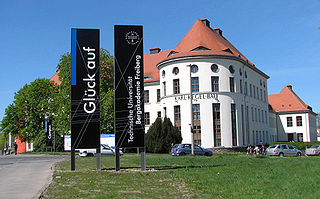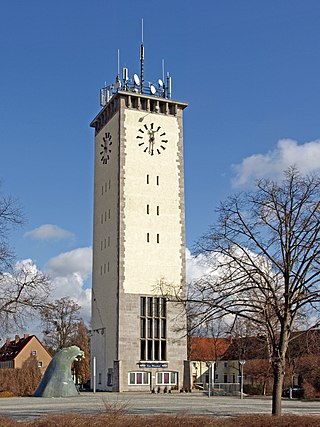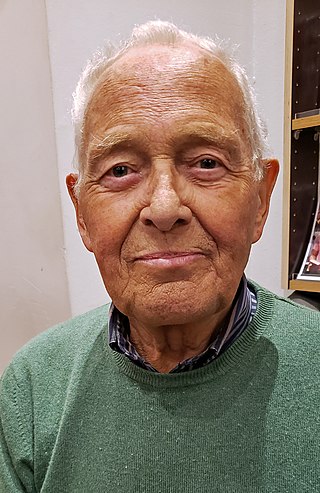
Abraham Gottlob Werner was a German geologist who set out an early theory about the stratification of the Earth's crust and propounded a history of the Earth that came to be known as Neptunism. While most tenets of Neptunism were eventually set aside, Werner is remembered for his demonstration of chronological succession in rocks; for the zeal with which he infused his pupils; and for the impulse he thereby gave to the study of geology. He has been called the "father of German geology".

Johannes Wilhelm "Hans" Goldschmidt was a German chemist notable as the discoverer of the Thermite reaction. He was also co-owner of the Chemische Fabrik Th. Goldschmidt, as of 1911 Th. Goldschmidt AG and its most important chemist. The reaction, also called the Goldschmidt process, is used for thermite welding, often used to join railway tracks. Thermites have also been used in metal refining, disabling munitions, and in incendiary weapons. Some thermite-like mixtures are used as pyrotechnic initiators in fireworks.

The Technische Universität Bergakademie Freiberg is a public university of technology with currently 3655 students in the city of Freiberg, Saxony, Germany. Its focus is on exploration, mining & extraction, processing, and recycling of natural resources & scrap, as well as developing new materials. Today, it's the oldest university of mining and metallurgy in the world.

Paul Dessau was a German composer and conductor. He collaborated with Bertolt Brecht and composed incidental music for his plays, and several operas based on them.

Schwarzheide is a town in the Oberspreewald-Lausitz district, in Lower Lusatia, Brandenburg, Germany. It is situated on the river Schwarze Elster, 11 km southwest of Senftenberg, 110 km south of Berlin and 40 km north of Dresden. The little river Pössnitz runs through the eastern part of Schwarzheide.

The Ministry of Coal is an Indian government ministry headquartered in New Delhi. The portfolio is held by Cabinet Minister Pralhad Joshi.
According to the United States Energy Information Administration (EIA), Pakistan may have over 9 billion barrels (1.4×109 cubic metres) of petroleum oil and 105 trillion cubic feet (3.0 trillion cubic metres) in natural gas (including shale gas) reserves.

Claire Waldoff, born Clara Wortmann, was a German singer. She was a famous kabarett singer and entertainer in Berlin during the 1910s and 1920s, chiefly known for performing ironic songs in the Berlin dialect and with lesbian undertones and themes.

Wolf Albach-Retty was an Austrian actor. He was the father of Romy Schneider with the German actress Magda Schneider.
Wolfgang Hilbig was a German writer and poet.

Wolfram Setz is a German historian, editor, translator and essayist.

Severinus of Saxony was a Saxon prince of the Albertine line of the House of Wettin.

Bertzit Tower is an investment ruin in the north of Kahla, which belongs to Plessa in the southern part of Brandenburg, itself part of the Elbe-Elster region.

Alfred Emil Richard Kneschke was a German mathematician, engineer and university lecturer. During the World War II, Kneschke managed the Referat IV, Section II of the Wehrmacht Signals intelligence organization General der Nachrichtenaufklärung until November 1944, working on cryptanalysis and decoding of British, USA, French and Balkan cipher systems. From Nov 1944, he worked in the OKW/Chi cipher bureau as a cryptanalyst.

VEB Kombinat Mikroelektronik Erfurt was an important manufacturer of active electronic components in East Germany. It should not be confused with the more well-known VEB Kombinat Robotron Dresden which used integrated circuits from Kombinat Mikroelektronik in its computers.

Memoirs of a Good-for-Nothing is a novella by Joseph von Eichendorff. Completed in 1823, it was first printed in 1826. The work is regarded as a pinnacle of musical prose. Eichendorff created an open form with epic and lyrical elements, incorporating several poems and songs in the text. It was first published in English in 1866.
Erich Valentin was a German musicologist.
Dorothea Köhler, néeDorothea Helling is a German woman conductor and music educator.
The UC compander system is a noise reduction system for vinyl records, aiming at highest playback compatibility even without corresponding UC expander.

The Rhenish lignite mining area, often called the Rhenish mining area for short, is a mining district in the Cologne Bay, on the northwestern edge of the Rhenish Slate Mountains. The mining of lignite using the open pit method has had a significant impact on the landscape here and led to the formation of several important industrial sites. The area includes the Zülpicher and Jülicher Börde, the Erft lowlands and the Ville, making it the largest lignite mining area in Europe. To a lesser extent, clay, silica sand and loess are mined here. The area is the only active lignite mining area in what was West Germany during German partition and contains the mines with the largest surface area, greatest depth, and biggest annual output of coal.














